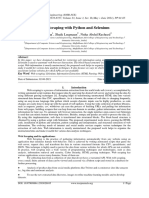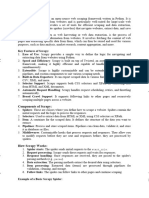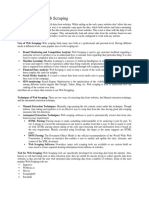Introduction to Web Scraping in RPA With Python
Uploaded by
Mohammad Wasiq TurkIntroduction to Web Scraping in RPA With Python
Uploaded by
Mohammad Wasiq TurkIntroduction to Web Scraping
in RPA with Python
11/13/2024 © NexusIQ Solutions 1
Web Scraping is the process of extracting data from websites programmatically. It is a key technique in Robotic Process Automation (RPA), as it
enables automating the collection, processing, and analysis of web-based data.
Why Use Web Scraping in RPA?
1. Data Extraction:
o Automate the collection of data from websites for analysis or reporting.
2. Repetitive Tasks:
o Perform repetitive data extraction tasks efficiently.
3. Integration with RPA Tools:
o Use scraping as a component in end-to-end automation workflows.
4. Improved Accuracy:
o Reduce human errors in manual data copying and pasting.
11/13/2024 © NexusIQ Solutions 2
Applications of Web Scraping in RPA
1. Market Research:
o Extract competitor pricing or product details from e-commerce websites.
2. Lead Generation:
o Collect business or customer data from directories or social media.
3. Content Aggregation:
o Gather articles, news, or reviews for research or publishing.
4. Job Automation:
o Scrape job listings or resumes for recruitment purposes.
5. Compliance Monitoring:
o Track changes in regulations or terms from legal or government sites.
11/13/2024 © NexusIQ Solutions 3
Python Libraries for Web Scraping
1. BeautifulSoup:
o Simplifies parsing HTML and XML.
o Example Use: Extracting specific elements (e.g., titles, links).
2. Requests:
o Handles HTTP requests to fetch web pages.
o Example Use: Downloading webpage content.
3. Selenium:
o Automates browser interaction for dynamic websites.
o Example Use: Scraping data from pages requiring JavaScript rendering.
4. Scrapy:
o A powerful framework for large-scale web scraping.
o Example Use: Handling complex workflows with pipelines.
11/13/2024 © NexusIQ Solutions 4
Ethical Considerations
1. Respect Terms of Service:
o Ensure compliance with website terms to avoid legal issues.
2. Avoid Overloading Servers:
o Use delays to minimize server load.
3. Seek Permissions:
o Obtain explicit permissions for large-scale scraping projects.
11/13/2024 © NexusIQ Solutions 5
Steps in Web Scraping
1. Define the Objective:
o Identify what data to extract and the target websites.
2. Inspect the Website:
o Use browser developer tools to locate elements (e.g., <div>, <span>) containing the required data.
3. Fetch the Webpage:
o Use requests or Selenium to load the web page.
4. Parse the HTML:
o Use BeautifulSoup to navigate and extract specific elements.
5. Store the Data:
o Save extracted data in formats like CSV, Excel, or a database.
6. Integrate with RPA Workflow:
o Use the scraped data in subsequent automation tasks (e.g., filling forms, generating reports)
11/13/2024 © NexusIQ Solutions 6
Simple Web Scraping Example in Python
This example scrapes titles of articles from a hypothetical blog.
Example
import requests
from bs4 import BeautifulSoup
# Step 1: Fetch the webpage
url = "https://example-blog-site.com"
response = requests.get(url)
# Step 2: Parse the HTML content
soup = BeautifulSoup(response.text, 'html.parser')
# Step 3: Extract article titles
titles = soup.find_all('h2', class_='article-title')
for idx, title in enumerate(titles, start=1):
print(f"{idx}. {title.text.strip()}")
# Step 4: Save data to a file
with open("titles.csv", "w") as file:
for title in titles:
file.write(f"{title.text.strip()}\n")
11/13/2024 © NexusIQ Solutions 7
Dynamic Website Scraping Example with Selenium
For pages requiring JavaScript rendering:
Example
from selenium import webdriver
from selenium.webdriver.common.by import By
from selenium.webdriver.chrome.service import Service
# Step 1: Set up the WebDriver
service = Service("path/to/chromedriver") # Update with your WebDriver path
driver = webdriver.Chrome(service=service)
# Step 2: Open the website
url = "https://example-dynamic-site.com"
driver.get(url)
# Step 3: Extract data
elements = driver.find_elements(By.CLASS_NAME, "dynamic-class")
for element in elements:
print(element.text)
# Step 4: Close the browser
driver.quit()
11/13/2024 © NexusIQ Solutions 8
RPA Workflow Integration
After scraping, you can integrate the data into an RPA workflow using tools like UiPath or Python libraries like PyAutoGUI. For example:
● Use scraped data to autofill web forms.
● Create reports using the extracted information.
11/13/2024 © NexusIQ Solutions 9
11/13/2024 © NexusIQ Solutions 10
You might also like
- Hourglass Workout Program by Luisagiuliet 276% (21)Hourglass Workout Program by Luisagiuliet 251 pages
- Read People Like A Book by Patrick King-Edited57% (82)Read People Like A Book by Patrick King-Edited12 pages
- Livingood, Blake - Livingood Daily Your 21-Day Guide To Experience Real Health77% (13)Livingood, Blake - Livingood Daily Your 21-Day Guide To Experience Real Health260 pages
- Donald Trump & Jeffrey Epstein Rape Lawsuit and Affidavits83% (1016)Donald Trump & Jeffrey Epstein Rape Lawsuit and Affidavits13 pages
- The 36 Questions That Lead To Love - The New York Times91% (35)The 36 Questions That Lead To Love - The New York Times3 pages
- The 36 Questions That Lead To Love - The New York Times95% (21)The 36 Questions That Lead To Love - The New York Times3 pages
- Jeffrey Epstein39s Little Black Book Unredacted PDF75% (12)Jeffrey Epstein39s Little Black Book Unredacted PDF95 pages
- 14 Easiest & Hardest Muscles To Build (Ranked With Solutions)100% (8)14 Easiest & Hardest Muscles To Build (Ranked With Solutions)27 pages
- The 4 Hour Workweek, Expanded and Updated by Timothy Ferriss - Excerpt23% (954)The 4 Hour Workweek, Expanded and Updated by Timothy Ferriss - Excerpt38 pages
- Data Analysis by Web Scraping Using PythonNo ratings yetData Analysis by Web Scraping Using Python6 pages
- Web Scraping With Python Tutorials From A To Z100% (1)Web Scraping With Python Tutorials From A To Z35 pages
- 20_BeautifulSoup Library for Web ScrapingNo ratings yet20_BeautifulSoup Library for Web Scraping12 pages
- 4a82c633-5051-45ef-a932-6a6495641a0e_4F_IntroToWebScrapingNo ratings yet4a82c633-5051-45ef-a932-6a6495641a0e_4F_IntroToWebScraping6 pages
- Practical Web Scraping for Economists 1744341390No ratings yetPractical Web Scraping for Economists 174434139033 pages
- Unit 11 Application Development Using PythonNo ratings yetUnit 11 Application Development Using Python19 pages
- Web Scraping With Python and Selenium: Sarah Fatima, Shaik Luqmaan Nuha Abdul RasheedNo ratings yetWeb Scraping With Python and Selenium: Sarah Fatima, Shaik Luqmaan Nuha Abdul Rasheed5 pages
- Text-Processing-For-NLP-Web-Scrapping (5)No ratings yetText-Processing-For-NLP-Web-Scrapping (5)18 pages
- Web Scrapping: Dept - of CS&E, BIET, Davangere Page - 1No ratings yetWeb Scrapping: Dept - of CS&E, BIET, Davangere Page - 18 pages
- Web Scraping and Data Collection CheatSheet 1731972399No ratings yetWeb Scraping and Data Collection CheatSheet 173197239910 pages
- Web Scraping Job Portals: Ashutosh Kumar, Kinshuk Chauhan, Jaspreet Kaur GrewalNo ratings yetWeb Scraping Job Portals: Ashutosh Kumar, Kinshuk Chauhan, Jaspreet Kaur Grewal13 pages
- Web Scraping with Python Step by Step: A Practical Guide with ExamplesFrom EverandWeb Scraping with Python Step by Step: A Practical Guide with ExamplesNo ratings yet
- Experiment2 Web Scraping and Data AnalysisNo ratings yetExperiment2 Web Scraping and Data Analysis5 pages
- Web Scraping for Data Analytics a BeatifulSoup ImplementationNo ratings yetWeb Scraping for Data Analytics a BeatifulSoup Implementation6 pages
- Web Scraping Using Python: A Step by Step Guide: September 2019No ratings yetWeb Scraping Using Python: A Step by Step Guide: September 20197 pages
- The Ultimate Web Scraping With Python Bootcamp 2023 - CoderprogNo ratings yetThe Ultimate Web Scraping With Python Bootcamp 2023 - Coderprog3 pages
- Web Scraping Using Python: A Step by Step Guide: September 20190% (1)Web Scraping Using Python: A Step by Step Guide: September 20197 pages
- Web Scraping Using Python: A Step by Step Guide: September 2019No ratings yetWeb Scraping Using Python: A Step by Step Guide: September 20197 pages
- E-Commerce Review Scrapper: Python Mini Project OnNo ratings yetE-Commerce Review Scrapper: Python Mini Project On15 pages
- IBM WebSphere Portal 8: Web Experience Factory and the CloudFrom EverandIBM WebSphere Portal 8: Web Experience Factory and the CloudNo ratings yet
- Introduction To PHP and Postgresql: CSC 436 - Fall 2008No ratings yetIntroduction To PHP and Postgresql: CSC 436 - Fall 200818 pages
- Username Enumeration: Real-World Example of A Username Enumeration AttackNo ratings yetUsername Enumeration: Real-World Example of A Username Enumeration Attack2 pages
- Awesome .NET Core Genvio - References-for-Developers Wiki GitHubNo ratings yetAwesome .NET Core Genvio - References-for-Developers Wiki GitHub1 page
- Dota 2's Character Art Guide Has Been Updated and Converted To A Web Page. Please SeeNo ratings yetDota 2's Character Art Guide Has Been Updated and Converted To A Web Page. Please See1 page
- Pengembangan Pendidikan Partisipatif Sebagai Upaya Menghadapi Masyarakat Ekonomiasean Ika Pasca HimawatiNo ratings yetPengembangan Pendidikan Partisipatif Sebagai Upaya Menghadapi Masyarakat Ekonomiasean Ika Pasca Himawati9 pages
- Vue - Js and SEO How To Optimize Reactive Websites For Search Engines and Bots - Smashing MagazineNo ratings yetVue - Js and SEO How To Optimize Reactive Websites For Search Engines and Bots - Smashing Magazine8 pages
- Performance: Performance Accessibility Best Practices SEO Progressive Web AppNo ratings yetPerformance: Performance Accessibility Best Practices SEO Progressive Web App54 pages
- API Development Using ASP Net Core Web API100% (1)API Development Using ASP Net Core Web API161 pages























































































































